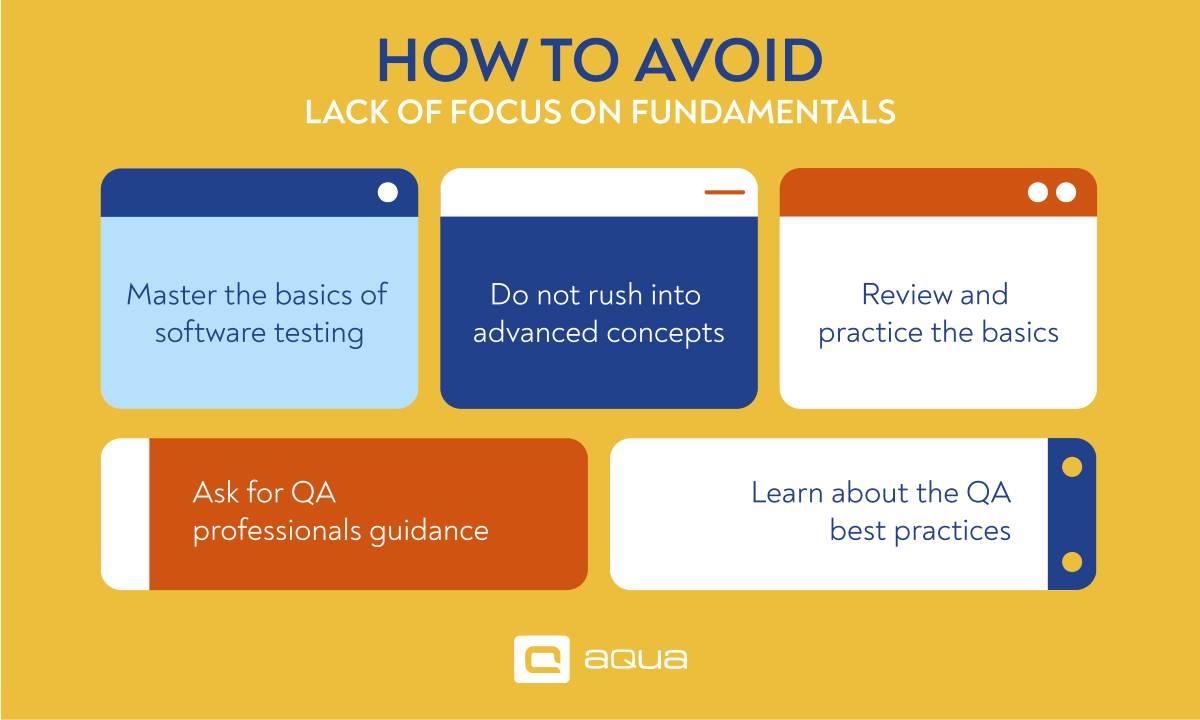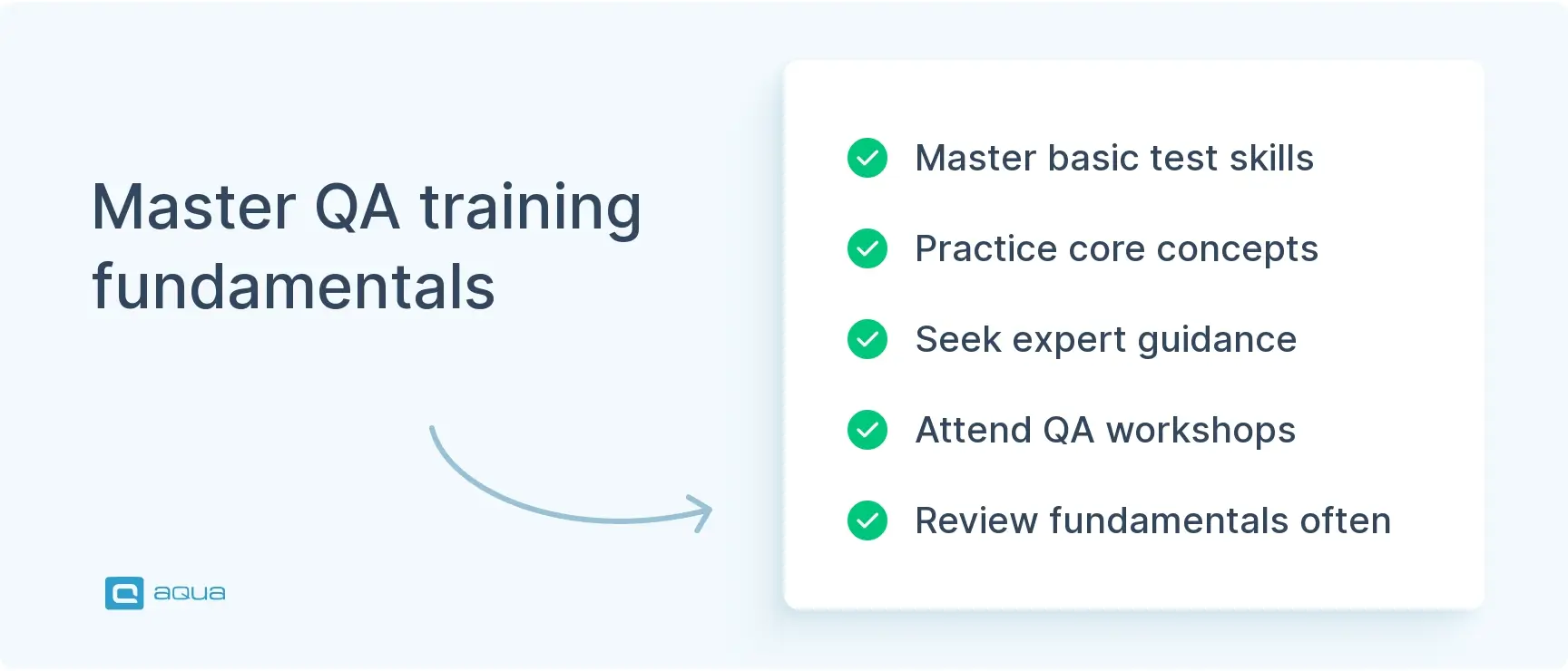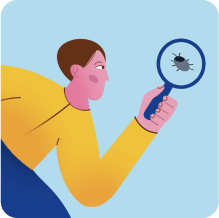Are you frustrated with making common mistakes at the beginning of your software testing journey? Do you feel like you are not progressing despite putting in work hours? Do not worry; we’ve got your back.
From basic blunders to significant errors, we will show you how to avoid common QA learning mistakes and become the tester you want to be. Whether you are a seasoned pro or just starting out, these tips will help you stay on track and ensure your testing efforts are efficient, error-free, and top-level.
We touched on other QA learning mistakes during the video.
#1. Lack of focus on the fundamentals
Jumping into advanced QA concepts without nailing the basics is like trying to debug complex automation when you can’t even write a decent test case. Nearly 60% of junior testers burn out because they skip foundational skills.
Spend two weeks mastering risk-based thinking and defect identification before touching any automation frameworks. Practice with simple web forms first—boring but essential.
Quick implementation tip: Use the Testing Pyramid as your daily reference. Stick it on your monitor. Every test you write should fit somewhere on that pyramid, and you should know exactly why.
Unexpectedly, most senior QAs still use basic heuristics more than fancy tools. Mind-mapping beats expensive software when you’re figuring out what actually needs testing.
Find a mentor or crash some mob testing sessions, and you’ll learn more in one afternoon than weeks of solo studying. QA conferences are reality checks on whether you’re learning relevant skills or just chasing shiny objects.
Red flag to watch: if you can’t explain your testing approach to a developer in under two minutes, you’re probably overcomplicating things. Keep it simple, keep it solid.
You should remember that if you master the basics of QA, you will be confident to move on to more advanced concepts and implement them successfully in your testing projects.
You can expand your knowledge in QA with these must-read books that will help you avoid testing learning mistakes:
- “The Art of software testing” by Glenford J. Myers
- “Software testing: principles and practices” by Srinivasan Desikan and Gopalaswamy Ramesh
- “Testing computer software” by Cem Kaner
- “How to break software: a practical guide to Testing” by James A. Whittaker

Defining Testing Scope and Avoiding Overlooked Areas
Here’s something that trips up way too many QA teams: not mapping out the full testing scope before you even touch the code. You end up tunnel-visioned on functional tests while security vulnerabilities and performance issues slip right through the cracks. You need to grab a whiteboard (or digital equivalent) and map out everything you need to test. New features, but also regression checks, edge cases that break things in weird ways, and non-functional stuff like load handling.
Rank your testing tasks by risk level, not just what seems easiest to knock out first. Teams that do this see nearly 40% fewer post-release bugs compared to those winging it. The trick is scheduling regular regression runs as you add features, not waiting until the end when you’re scrambling against deadlines. Your scope document becomes your safety net, and you’ll reference it way more than you think.

#2. Overconfidence in yourself and not learning from others
It might not be specific to the QA industry, but for juniors in all professions. It is common for beginners to rely too much on their theoretical knowledge and get too confident about their abilities and skills. You might take courses, complete certifications and assume that you already know everything you need to know. But practice is always different from theory, and you can face problems where your knowledge might not be enough.
Not learning from others is another QA learning mistake, and here is how you should avoid it:
- Network with other QA professionals, gain insights and learn from their mistakes.
- Participate in communities and forums to learn more from a broader range of professionals. Joining Reddit communities or Linkedin groups where professionals share their knowledge can also help you in practical learning.
- Do not be afraid to ask questions because they make you seem inexperienced or incompetent.
In every job, communicating with seniors regularly and learning from their mistakes is one of the most effective ways to avoid these errors in your path. Networking is an underrated skill, so do not only rely on your theoretical knowledge in QA and communicate with as many seniors as you can.
#3. Not knowing the basics of QA management
Starting out in QA? You’ll hit management roadblocks fast, but here’s what actually works.
Skip the checkbox mentality. Instead of counting test cases, track what matters: bug escape rates and resolution speed. These metrics tell the real story.
Quick win: Set up a simple dashboard showing defects caught vs. those reaching production. Most teams see their catch rate jump nearly 40% once they start measuring it.
Master Agile basics, sure, but throw in risk-based prioritisation from day one. Ask yourself: “What breaks the user experience most?” Start there, not with the easiest tests.
Here’s the non-obvious part: push for QA input on your Definition of Done. Teams that include testers in this conversation catch integration issues 60% earlier than those that don’t.
Thinking that documentation slows you down is a trap. Actually, transparent processes and shared test data speed everything up when a crisis hits and everyone knows exactly where things stand.
If you are a QA professional looking to streamline your testing process and advance your career, you should consider aqua. It is a powerful test management tool that will help you improve communication with your team, increase productivity, and launch high-quality products effortlessly. Its comprehensive dashboard will show your real-time defect detection rate, the history of your test runs, and your test coverage. Using aqua, you can develop your skills, contribute to your team’s success, and showcase your expertise to potential employers.
Ready to see how aqua will benefit you and your team?
#4. Underestimating the bug reports
Bug reports are a crucial part of software testing. Producing poor bug reports is one of the most common QA learning mistakes you will probably make if you are new to software testing. So when learning QA, ensure you know the importance of bug reports as it is the document of the problem or issue you find during testing.
Understanding the importance of the following concepts will help you avoid the mistake of underestimating them:
- Incomplete information: A bug report should include all the necessary information the developer needs to know to fix the issue. The expected outcome, actual result, and steps to reproduce the bug should be included in the report with screenshots or videos.
- Unclear language: A bug report should be written directly and clearly for the developer to understand. So you should avoid the jargon or acronyms in your report.
- Lack of prioritisation: Not all bugs are equal, so you should prioritise the most crucial bugs that affect the software’s functionality and security. So do not focus on the quantity, and learn to prioritise.
If you avoid the mistakes mentioned above, you will be able to provide the devs with a detailed bug report. This will help you ensure the bugs are dealt with quickly and efficiently.
#5. Ignoring Continuous Learning
One of the most common software testing learning mistakes is neglecting to stay updated with the latest trends, tools, and techniques. In software testing, it can significantly impede your professional growth. If you fail to engage in ongoing trends in the rapidly evolving tech industry, it will result in outdated practices and stagnation.
This commonly happens due to a perceived lack of time or underestimation of the impact of staying current. The consequences are tangible: your skills become obsolete, testing methods lag, and overall efficiency takes a hit. To avoid this, you should set aside dedicated time for learning, exploring various resources, attending webinars, and actively participating in relevant communities that can help you stay abreast of advancements.
#6. Not improving soft skills
Effective communication, collaboration, and problem-solving are crucial in successful QA testing. However, sidelining the development of these soft skills can be deadly. Doing this will hamper teamwork, compromise the ability to convey findings clearly, and muddle the understanding of project objectives.
When you put all your energy into nailing the technical side of things, it’s easy to forget that being great with people matters just as much in QA. But if you overlook this, it can mess up how your team works together, make it hard to agree on the projects, and harm your team’s problem-solving. To fix this, try getting involved in workshops, finding a mentor who’s been around the block, and working on listening better and understanding where others are coming from.
#7. Not learning about feedback culture
Imagine you are a new employee or an intern just learning QA testing. Of course, you will get all kinds of feedback for your work. If you brush off feedback from people like your peers, bosses, or users, it stops you from growing personally and professionally.
Feedback is fuel for improving your testing methods and improving your work. Ignoring feedback might come from a fear of criticism or thinking you don’t need anyone’s help. But here’s the deal: if you ignore feedback, you miss chances to get better, might not spot where your testing could be off, and your work might not be as good as it could be. To fix this, try to be open to feedback, actively ask for it, and use helpful criticism to keep getting better at what you do.
Building a Blameless QA Culture and Strengthening Team Collaboration
When QA issues surface, your instinct might be to find who messed up. But here’s the thing: the strongest teams flip that script entirely. They dig into what went wrong, not who went wrong. Creating a blame-free environment means your team actually wants to share when things break (instead of hiding problems until they explode).
In your next retrospective, ban the question ‘who did this?’ and replace it with ‘what process could we improve?’ Top-performing teams increase the number of early bug catches when people feel safe speaking up. Also, this way, developers start reaching out to testers proactively instead of treating QA like a necessary evil. Your relationships between testers, developers, and product folks will transform and broken processes get fixed before they break your software.
#8. Relying too much on automation
One of the most common mistakes in learning software testing is assuming that automation solves all your problems. Although automation will help you with repetitive tasks and save you a lot of time, it is vital to understand the importance of manual testing too. Here is how you can avoid the mistake of over-reliance on automation in software testing:
- Take time to understand the pros and cons of both automated and manual testing, and use each of them when appropriate.
- Develop manual testing skills, including exploratory, boundary, and negative testing.
- First, understand the underlying logic of software and how it works to enhance your manual testing skills.
- Do not ignore the importance of test planning and design, even if you are using automation tools.
Learning manual testing with its core principles and knowing when to use it will help you avoid the mistake of relying too much on automation in the QA learning process.
However, the proper usage of AI for test management will help you optimise resources, reduce costs, and save time. Only 7% of vendors offer AI in QA tools, so make sure you choose the best one for your testing efforts.
aqua Copilot is the ultimate solution for you that will help you prioritise the necessary tests for your needs, review the test cases you have worked on, and create entire test cases based on the requirements. You can increase your efficiency massively with aqua’s AI solution.
Learn how testers use the power of AI to boost their testing process, cut costs, increase revenue, and save lots of time.
Conclusion
Learning QA can be challenging, especially in the beginning. But following the abovementioned steps, you will avoid QA learning mistakes more efficiently. Learning manual testing techniques, focusing on the fundamentals, continuously learning from others, networking, prioritising and learning to create better bug reports will make you an efficient QA professional and help you avoid novice mistakes.

















